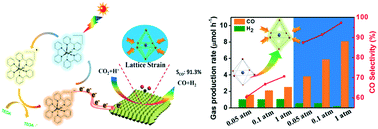Lattice-strained nickel hydroxide nanosheets for the boosted diluted CO2 photoreduction†
Abstract
The photoreduction of diluted CO2 into value-added solar fuel is a discipline at the forefront of energy and environmental research. However, this exploration largely suffers from unsatisfactory activity and selectivity. Herein, lattice-strained nickel hydroxide nanosheets (NSs) were successfully constructed via a vanadium-doped strategy toward the photoreduction of diluted CO2. X-ray absorption fine structure spectroscopy and Williamson–Hall analysis based on X-ray diffraction revealed the formation of lattice strain on the surface of the Ni(OH)2 NSs. Consequently, the lattice-strained sample exhibited the highest CO production yield of 20.7 μmol with a CO selectivity of 97% after 3 h in pure CO2, which were almost 4 and 1.3 times those of its parent Ni(OH)2 NS. Even in diluted CO2 (0.1 atm), it exhibited a CO production rate of 5.8 μmol h−1 with a CO selectivity of 91.3%, surpassing most previous works in pure CO2. Further characterizations revealed that the lattice strain could greatly improve the CO2 adsorption and activation, and the separation efficiency of the photogenerated carriers, thus leading to an enhancement in the carbon dioxide reduction activity. This work discloses a clear atomic-level correlation between lattice strain and diluted CO2 photoreduction, which lays a foundation for reinventing their applications in photocatalysis, among other applications.

- This article is part of the themed collection: Best Papers 2021 - Environmental Science: Nano


 Please wait while we load your content...
Please wait while we load your content...